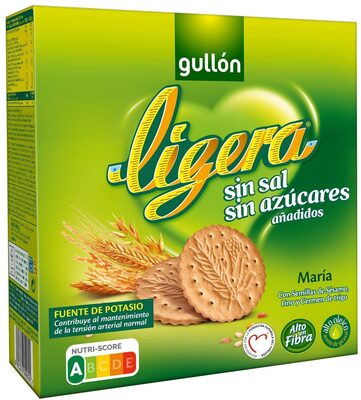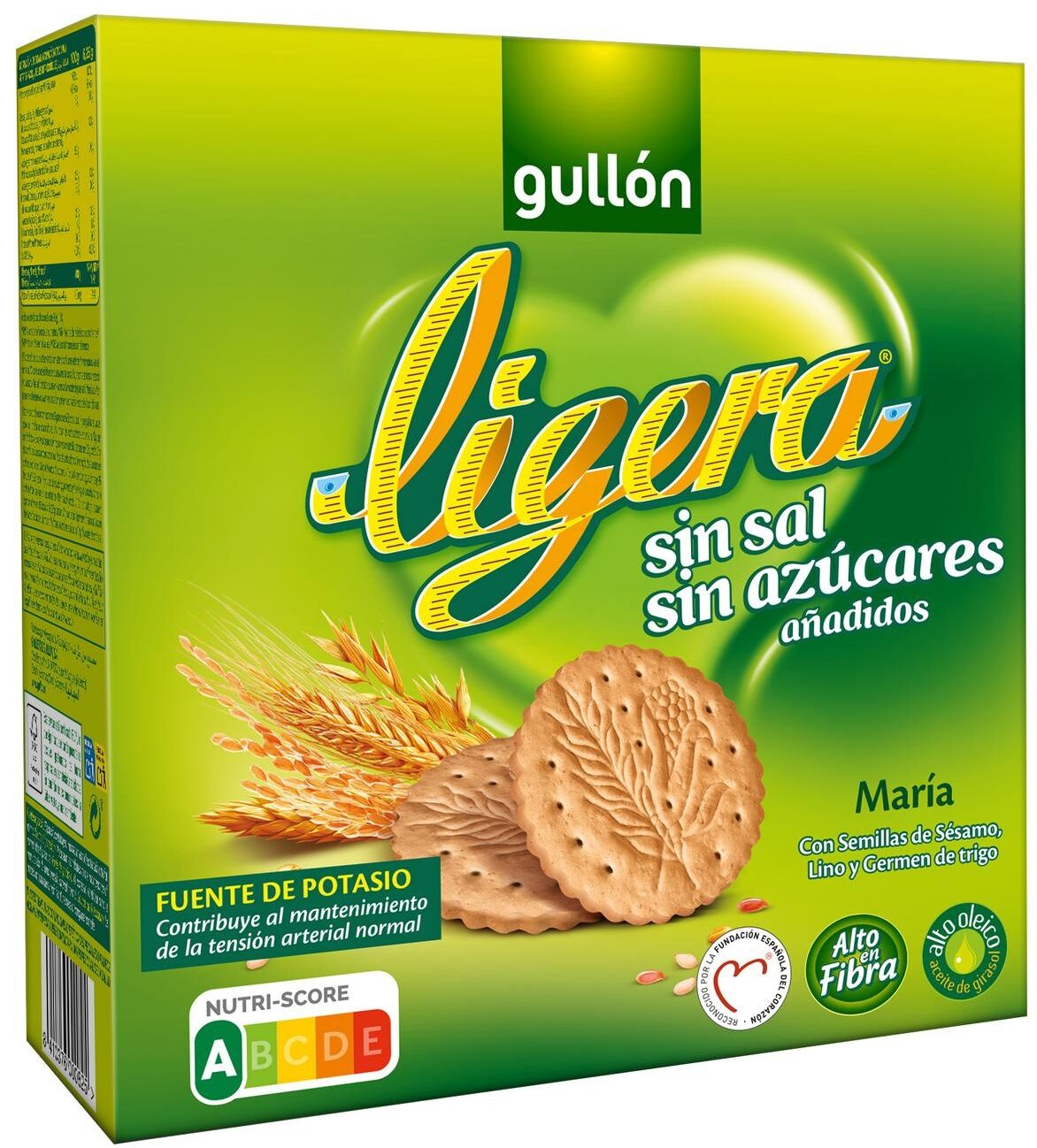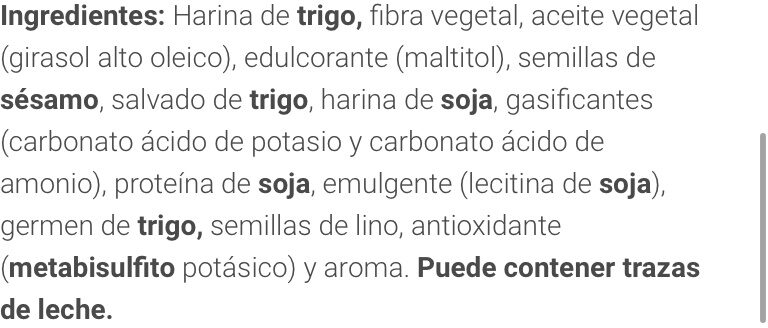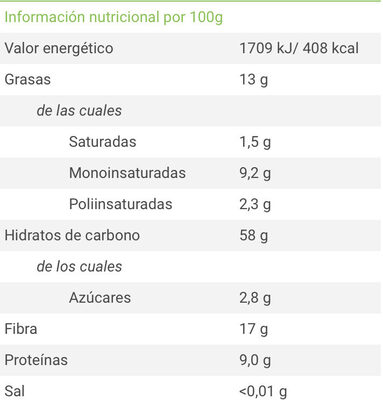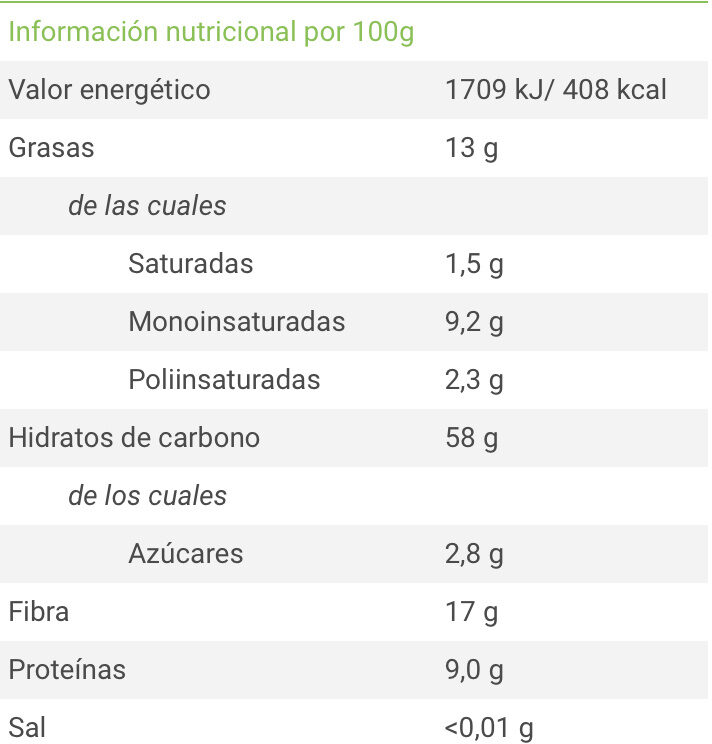Help us make food transparency the norm!
As a non-profit organization, we depend on your donations to continue informing consumers around the world about what they eat.
The food revolution starts with you!
Galleta maría ligera sin sal y sin azúcar - Gullón - 600 g (3 x 200 g)
Galleta maría ligera sin sal y sin azúcar - Gullón - 600 g (3 x 200 g)
This product page is not complete. You can help to complete it by editing it and adding more data from the photos we have, or by taking more photos using the app for Android or iPhone/iPad. Thank you!
×
Barra-kodea: 8410376000825 (EAN / EAN-13)
Izen arrunta: Galleta con cereales sin azúcares añadidos con edulcorante y sin sal
Kopurua: 600 g (3 x 200 g)
Ontziratzea: en:Plastic, en:Box, en:container
Markak: Gullón
Kategoriak: en:Snacks, en:Sweet snacks, en:Biscuits and cakes, Gaileta, es:Galletas maría
Etiketak, ziurtagiriak, sariak:
en:Low or no salt, en:Low or no sugar, Source of fibre, en:Green Dot, High fibres, No added sugar, No salt, Nutriscore, Nutriscore A, en:With sweeteners, es:Con aceite de girasol alto oleico, es:Fuente de potasio
Manufacturing or processing places: España
Link to the product page on the official site of the producer: http://www.gullon.es/es/MariaLigera
Dendak: Alcampo, Eroski, Condis, Hipercor, El Corte Inglés, Carrefour, Dia, Caprabo, Consum, Súper Vera
Matching with your preferences
Health
Osagaiak
-
20 ingredients
Gaztelania: Harina de trigo 51,5%, fibra vegetal, aceite vegetal (girasol alto oleico) 9%, edulcorante (maltitol), semillas de sésamo 4,5%, salvado de trigo, harina de soja, gasificantes (carbonato ácido de potasio, carbonato ácido de amonio), proteína de soja, emulgente (lecitina de soja), germen de trigo 0,2%, semillas de lino 0,2%, antioxidante (metabisulfito potásico), aroma de vainilla.Alergenoak: en:Gluten, en:Sesame seeds, en:Soybeans, es:metabisulfito, es:metabisulfitoAztarnak: en:Milk
Food processing
-
Ultra processed foods
Elements that indicate the product is in the 4 - Ultra prozesatutako elikagaiak eta edariak group:
- Gehigarria: E322
- Gehigarria: E965
- Osagaia: Emulsifier
- Osagaia: Flavouring
- Osagaia: Sweetener
Food products are classified into 4 groups according to their degree of processing:
- Prozesatu gabeko edo ahalik eta gutxien prozesatutako elikagaiak
- Sukaldaritzako osagaiak prozesatu
- Prozesatutako jakiak
- Ultra processed foods
The determination of the group is based on the category of the product and on the ingredients it contains.
Gehigarriak
-
E224
Potassium metabisulfite: Potassium metabisulfite, K2S2O5, also known as potassium pyrosulfite, is a white crystalline powder with a pungent sulfur odour. The main use for the chemical is as an antioxidant or chemical sterilant. It is a disulfite and is chemically very similar to sodium metabisulfite, with which it is sometimes used interchangeably. Potassium metabisulfite is generally preferred out of the two as it does not contribute sodium to the diet. Potassium metabisulfite has a monoclinic crystal structure which decomposes at 190 °C, yielding potassium sulfite and sulfur dioxide: K2S2O5-s- → K2SO3-s- + SO2-g-Source: Wikipedia (Ingeles)
-
E322
Lecithin: Lecithin -UK: , US: , from the Greek lekithos, "egg yolk"- is a generic term to designate any group of yellow-brownish fatty substances occurring in animal and plant tissues, which are amphiphilic – they attract both water and fatty substances -and so are both hydrophilic and lipophilic-, and are used for smoothing food textures, dissolving powders -emulsifying-, homogenizing liquid mixtures, and repelling sticking materials.Lecithins are mixtures of glycerophospholipids including phosphatidylcholine, phosphatidylethanolamine, phosphatidylinositol, phosphatidylserine, and phosphatidic acid.Lecithin was first isolated in 1845 by the French chemist and pharmacist Theodore Gobley. In 1850, he named the phosphatidylcholine lécithine. Gobley originally isolated lecithin from egg yolk—λέκιθος lekithos is "egg yolk" in Ancient Greek—and established the complete chemical formula of phosphatidylcholine in 1874; in between, he had demonstrated the presence of lecithin in a variety of biological matters, including venous blood, in human lungs, bile, human brain tissue, fish eggs, fish roe, and chicken and sheep brain. Lecithin can easily be extracted chemically using solvents such as hexane, ethanol, acetone, petroleum ether, benzene, etc., or extraction can be done mechanically. It is usually available from sources such as soybeans, eggs, milk, marine sources, rapeseed, cottonseed, and sunflower. It has low solubility in water, but is an excellent emulsifier. In aqueous solution, its phospholipids can form either liposomes, bilayer sheets, micelles, or lamellar structures, depending on hydration and temperature. This results in a type of surfactant that usually is classified as amphipathic. Lecithin is sold as a food additive and dietary supplement. In cooking, it is sometimes used as an emulsifier and to prevent sticking, for example in nonstick cooking spray.Source: Wikipedia (Ingeles)
-
E322i - Lezitina
Lecithin: Lecithin -UK: , US: , from the Greek lekithos, "egg yolk"- is a generic term to designate any group of yellow-brownish fatty substances occurring in animal and plant tissues, which are amphiphilic – they attract both water and fatty substances -and so are both hydrophilic and lipophilic-, and are used for smoothing food textures, dissolving powders -emulsifying-, homogenizing liquid mixtures, and repelling sticking materials.Lecithins are mixtures of glycerophospholipids including phosphatidylcholine, phosphatidylethanolamine, phosphatidylinositol, phosphatidylserine, and phosphatidic acid.Lecithin was first isolated in 1845 by the French chemist and pharmacist Theodore Gobley. In 1850, he named the phosphatidylcholine lécithine. Gobley originally isolated lecithin from egg yolk—λέκιθος lekithos is "egg yolk" in Ancient Greek—and established the complete chemical formula of phosphatidylcholine in 1874; in between, he had demonstrated the presence of lecithin in a variety of biological matters, including venous blood, in human lungs, bile, human brain tissue, fish eggs, fish roe, and chicken and sheep brain. Lecithin can easily be extracted chemically using solvents such as hexane, ethanol, acetone, petroleum ether, benzene, etc., or extraction can be done mechanically. It is usually available from sources such as soybeans, eggs, milk, marine sources, rapeseed, cottonseed, and sunflower. It has low solubility in water, but is an excellent emulsifier. In aqueous solution, its phospholipids can form either liposomes, bilayer sheets, micelles, or lamellar structures, depending on hydration and temperature. This results in a type of surfactant that usually is classified as amphipathic. Lecithin is sold as a food additive and dietary supplement. In cooking, it is sometimes used as an emulsifier and to prevent sticking, for example in nonstick cooking spray.Source: Wikipedia (Ingeles)
-
E501
Potassium carbonate: Potassium carbonate -K2CO3- is a white salt, which is soluble in water -insoluble in ethanol- and forms a strongly alkaline solution. It can be made as the product of potassium hydroxide's absorbent reaction with carbon dioxide. It is deliquescent, often appearing a damp or wet solid. Potassium carbonate is used in the production of soap and glass.Source: Wikipedia (Ingeles)
-
E501ii
Potassium carbonate: Potassium carbonate -K2CO3- is a white salt, which is soluble in water -insoluble in ethanol- and forms a strongly alkaline solution. It can be made as the product of potassium hydroxide's absorbent reaction with carbon dioxide. It is deliquescent, often appearing a damp or wet solid. Potassium carbonate is used in the production of soap and glass.Source: Wikipedia (Ingeles)
-
E503
Ammonium carbonate: Ammonium carbonate is a salt with the chemical formula -NH4-2CO3. Since it readily degrades to gaseous ammonia and carbon dioxide upon heating, it is used as a leavening agent and also as smelling salt. It is also known as baker's ammonia and was a predecessor to the more modern leavening agents baking soda and baking powder. It is a component of what was formerly known as sal volatile and salt of hartshorn.Source: Wikipedia (Ingeles)
-
E503ii
Ammonium carbonate: Ammonium carbonate is a salt with the chemical formula -NH4-2CO3. Since it readily degrades to gaseous ammonia and carbon dioxide upon heating, it is used as a leavening agent and also as smelling salt. It is also known as baker's ammonia and was a predecessor to the more modern leavening agents baking soda and baking powder. It is a component of what was formerly known as sal volatile and salt of hartshorn.Source: Wikipedia (Ingeles)
-
E965
Maltitol: Maltitol is a sugar alcohol -a polyol- used as a sugar substitute. It has 75–90% of the sweetness of sucrose -table sugar- and nearly identical properties, except for browning. It is used to replace table sugar because it is half as caloric, does not promote tooth decay, and has a somewhat lesser effect on blood glucose. In chemical terms, maltitol is known as 4-O-α-glucopyranosyl-D-sorbitol. It is used in commercial products under trade names such as Lesys, Maltisweet and SweetPearl.Source: Wikipedia (Ingeles)
Ingredients analysis
-
en:Palm oil free
No ingredients containing palm oil detected
-
en:Maybe vegan
Ingredients that may not be vegan: en:Vanilla flavouring
-
en:Maybe vegetarian
Ingredients that may not be vegetarian: en:Vanilla flavouring
-
Details of the analysis of the ingredients
es: Harina de _trigo_ 51.5%, fibra vegetal, aceite vegetal 9% (girasol alto oleico), edulcorante (maltitol), semillas de _sésamo_ 4.5%, salvado de _trigo_, harina de _soja_, gasificantes (carbonato ácido de potasio, carbonato ácido de amonio), proteína de _soja_, emulgente (lecitina de _soja_), germen de _trigo_ 0.2%, semillas de lino 0.2%, antioxidante (_metabisulfito_ potásico), aroma de vainilla- Harina de _trigo_ -> en:wheat-flour - vegan: yes - vegetarian: yes - ciqual_proxy_food_code: 9410 - percent_min: 51.5 - percent: 51.5 - percent_max: 51.5
- fibra vegetal -> en:vegetable-fiber - vegan: yes - vegetarian: yes - percent_min: 9 - percent_max: 29.1
- aceite vegetal -> en:vegetable-oil - vegan: yes - vegetarian: yes - from_palm_oil: maybe - percent_min: 9 - percent: 9 - percent_max: 9
- girasol alto oleico -> en:high-oleic-sunflower - vegan: yes - vegetarian: yes - from_palm_oil: no - ciqual_food_code: 17440 - percent_min: 9 - percent_max: 9
- edulcorante -> en:sweetener - percent_min: 4.5 - percent_max: 9
- maltitol -> en:e965 - vegan: yes - vegetarian: yes - percent_min: 4.5 - percent_max: 9
- semillas de _sésamo_ -> en:sesame-seeds - vegan: yes - vegetarian: yes - ciqual_food_code: 15010 - percent_min: 4.5 - percent: 4.5 - percent_max: 4.5
- salvado de _trigo_ -> en:wheat-bran - vegan: yes - vegetarian: yes - ciqual_food_code: 9621 - percent_min: 0.2 - percent_max: 4.5
- harina de _soja_ -> en:soya-flour - vegan: yes - vegetarian: yes - ciqual_food_code: 20900 - percent_min: 0.2 - percent_max: 4.5
- gasificantes -> en:raising-agent - percent_min: 0.2 - percent_max: 4.5
- carbonato ácido de potasio -> en:e501ii - vegan: yes - vegetarian: yes - percent_min: 0 - percent_max: 4.5
- carbonato ácido de amonio -> en:e503ii - vegan: yes - vegetarian: yes - percent_min: 0 - percent_max: 2.25
- proteína de _soja_ -> en:soy-protein - vegan: yes - vegetarian: yes - ciqual_food_code: 20591 - percent_min: 0.2 - percent_max: 4.27142857142857
- emulgente -> en:emulsifier - percent_min: 0.2 - percent_max: 3.7125
- lecitina de _soja_ -> en:soya-lecithin - vegan: yes - vegetarian: yes - ciqual_food_code: 42200 - percent_min: 0.2 - percent_max: 3.7125
- germen de _trigo_ -> en:wheat-germ - vegan: yes - vegetarian: yes - ciqual_food_code: 9660 - percent_min: 0.2 - percent: 0.2 - percent_max: 0.2
- semillas de lino -> en:flax-seed - vegan: yes - vegetarian: yes - ciqual_food_code: 15034 - percent_min: 0.2 - percent: 0.2 - percent_max: 0.2
- antioxidante -> en:antioxidant - percent_min: 0 - percent_max: 0.2
- _metabisulfito_ potásico -> en:e224 - vegan: yes - vegetarian: yes - percent_min: 0 - percent_max: 0.2
- aroma de vainilla -> en:vanilla-flavouring - vegan: maybe - vegetarian: maybe - percent_min: 0 - percent_max: 0.2
Elikadura
-
Nutrizio-kalitate oso ona
⚠ ️Warning: the amount of fruits, vegetables and nuts is not specified on the label, it was estimated from the list of ingredients: 0This product is not considered a beverage for the calculation of the Nutri-Score.
Positive points: 10
- Proteinak: 5 / 5 (balioa: 9, rounded value: 9)
- Fiber: 5 / 5 (balioa: 17, rounded value: 17)
- Fruits, vegetables, nuts, and colza/walnut/olive oils: 0 / 5 (balioa: 0, rounded value: 0)
Negative points: 6
- Energia: 5 / 10 (balioa: 1707, rounded value: 1707)
- Azukreak: 0 / 10 (balioa: 2.8, rounded value: 2.8)
- Gantz saturatua: 1 / 10 (balioa: 1.5, rounded value: 1.5)
- Sodioa: 0 / 10 (balioa: 0, rounded value: 0)
The points for proteins are counted because the negative points are less than 11.
Nutritional score: (6 - 10)
Nutri-Score:
-
Nutrient levels
-
Koipe in moderate quantity (13%)
What you need to know- A high consumption of fat, especially saturated fats, can raise cholesterol, which increases the risk of heart diseases.
Recommendation: Limit the consumption of fat and saturated fat- Choose products with lower fat and saturated fat content.
-
Gantz-azido ase in moderate quantity (1.5%)
What you need to know- A high consumption of fat, especially saturated fats, can raise cholesterol, which increases the risk of heart diseases.
Recommendation: Limit the consumption of fat and saturated fat- Choose products with lower fat and saturated fat content.
-
Azukre in low quantity (2.8%)
What you need to know- A high consumption of sugar can cause weight gain and tooth decay. It also augments the risk of type 2 diabetes and cardio-vascular diseases.
Recommendation: Limit the consumption of sugar and sugary drinks- Sugary drinks (such as sodas, fruit beverages, and fruit juices and nectars) should be limited as much as possible (no more than 1 glass a day).
- Choose products with lower sugar content and reduce the consumption of products with added sugars.
-
Gatz arrunt in low quantity (0%)
What you need to know- A high consumption of salt (or sodium) can cause raised blood pressure, which can increase the risk of heart disease and stroke.
- Many people who have high blood pressure do not know it, as there are often no symptoms.
- Most people consume too much salt (on average 9 to 12 grams per day), around twice the recommended maximum level of intake.
Recommendation: Limit the consumption of salt and salted food- Reduce the quantity of salt used when cooking, and don't salt again at the table.
- Limit the consumption of salty snacks and choose products with lower salt content.
-
-
Nutrition facts
Nutrition facts As sold
for 100 g / 100 mlAs sold
per serving (6.25 g)Compared to: es:Galletas maría Energia 1.707 kj
(408 kcal)107 kj
(25 kcal)-% 8 Koipe 13 g 0,812 g +% 2 Gantz-azido ase 1,5 g 0,094 g -% 46 Gantz-azido monoasegabe 9,2 g 0,575 g Polyunsaturated fat 2,3 g 0,144 g Carbohydrates 58 g 3,62 g -% 21 Azukre 2,8 g 0,175 g -% 85 Fiber 17 g 1,06 g +% 389 Proteina 9 g 0,562 g +% 28 Gatz arrunt 0 g 0 g -% 100 Potasio 480 mg 30 mg Fruits‚ vegetables‚ nuts and rapeseed‚ walnut and olive oils (estimate from ingredients list analysis) 0 % 0 %
Ingurumena
-
Eco-Score C - Moderate environmental impact
The Eco-Score is an experimental score that summarizes the environmental impacts of food products.→ The Eco-Score was initially developped for France and it is being extended to other European countries. The Eco-Score formula is subject to change as it is regularly improved to make it more precise and better suited to each country.Life cycle analysis
-
Average impact of products of the same category: B (Score: 69/100)
Kategoria: Biscuit (cookie)
Kategoria: Biscuit (cookie)
- PEF environmental score: 0.35 (the lower the score, the lower the impact)
- including impact on climate change: 2.88 kg CO2 eq/kg of product
Stage Impact Agriculture
80.5 %Processing
11.8 %Ontziratzea
3.1 %Transportation
3.2 %Distribution
1.4 %Consumption
0.0 %
Bonuses and maluses
-
Missing origins of ingredients information
Malus: -5
⚠ ️ The origins of the ingredients of this product are not indicated.
If they are indicated on the packaging, you can modify the product sheet and add them.
If you are the manufacturer of this product, you can send us the information with our free platform for producers.
-
Packaging with a high impact
Malus: -15
Shape Material Recycling Impact container Plastic Altua Box Unknown Altua ⚠ ️ The information about the packaging of this product is not sufficiently precise (exact shapes and materials of all components of the packaging).⚠ ️ For a more precise calculation of the Eco-Score, you can modify the product page and add them.
If you are the manufacturer of this product, you can send us the information with our free platform for producers.
Eco-Score for this product
-
Impact for this product: C (Score: 49/100)
Produktua: Galleta maría ligera sin sal y sin azúcar - Gullón - 600 g (3 x 200 g)
Life cycle analysis score: 69
Sum of bonuses and maluses: -20
Final score: 49/100
-
Carbon footprint
-
Equal to driving 1.5 km in a petrol car
288 g CO² per 100g of product
The carbon emission figure comes from ADEME's Agribalyse database, for the category: Biscuit (cookie) (Source: ADEME Agribalyse Database)
Stage Impact Agriculture
82.9 %Processing
7.9 %Ontziratzea
3.8 %Transportation
4.7 %Distribution
0.7 %Consumption
0.0 %
Ontziratzea
-
Packaging with a high impact
-
Packaging parts
container (Plastic)
Box
-
Bilgarriaren materialak
Material % Bilgarriaren pisua Bilgarriaren pisua produktuaren 100g-ko Plastic
-
Transportation
-
Origins of ingredients
Missing origins of ingredients information
⚠ ️ The origins of the ingredients of this product are not indicated.
If they are indicated on the packaging, you can modify the product sheet and add them.
If you are the manufacturer of this product, you can send us the information with our free platform for producers.Add the origins of ingredients for this product Add the origins of ingredients for this product
Report a problem
-
Incomplete or incorrect information?
Category, labels, ingredients, allergens, nutritional information, photos etc.
If the information does not match the information on the packaging, please complete or correct it. Open Food Facts is a collaborative database, and every contribution is useful for all.
Datuen iturria
Product added on by openfoodfacts-contributors
Last edit of product page on by ankedanay.
Produktuaren orria -gatik editatua beniben, elfarto, foodvisor, holaa33, kiliweb, maylord, musarana, neptuno, off.99c0f53f-3780-414e-9e8a-bad6142e56d7, packbot, roboto-app, scanbot, thaialagata, yuka.U3E0OE80OWYvZmdieGMwc3dnL295STF0K3BPbVp6eWFjOVVOSVE9PQ, yuka.VkxJYkZQMWRqYWNodzlvNCt6K08xZXQ2d2FYNFpVZTNJT3c3SVE9PQ, yuka.YUl4ZE9aOEVxdnN4dXRzazFVamMydTF1NW9IelEweTdNUFVCSWc9PQ.
